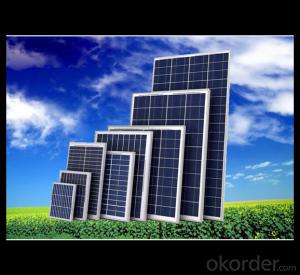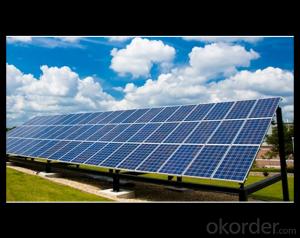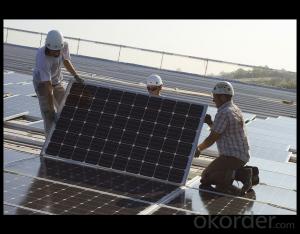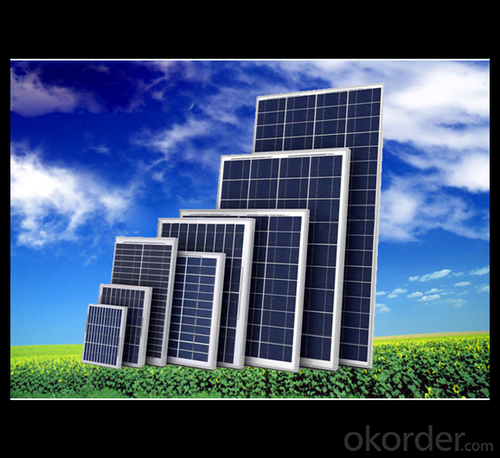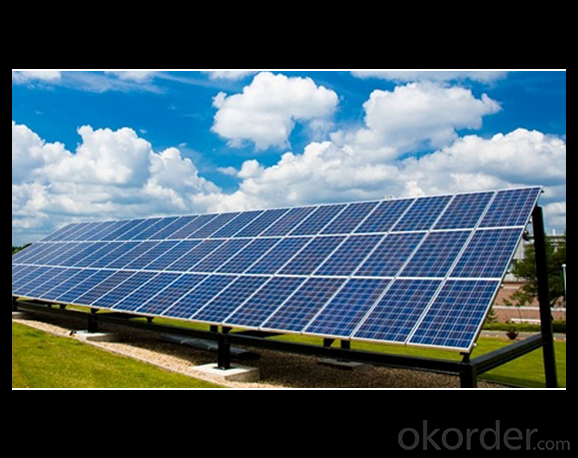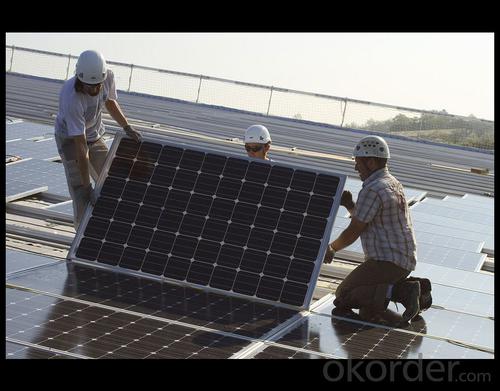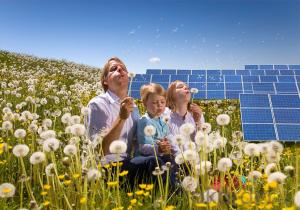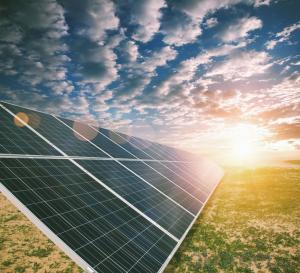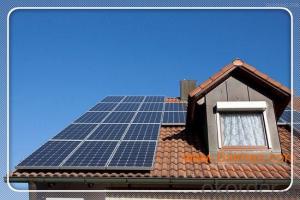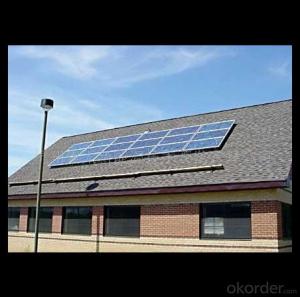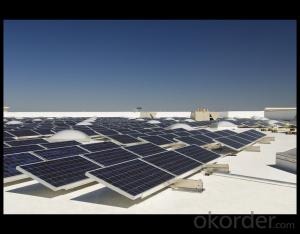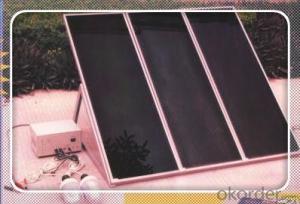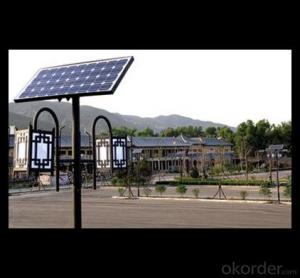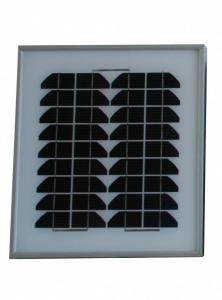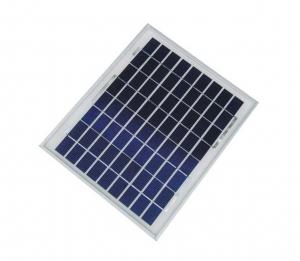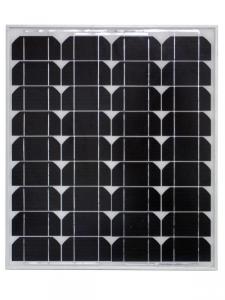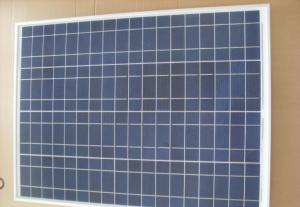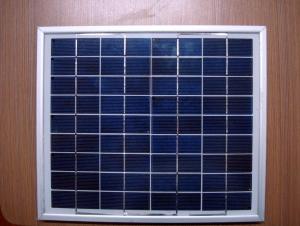Dometic Solar Panels 20w Direct Factory Sale Price 260-300watt
- Loading Port:
- China main port
- Payment Terms:
- TT OR LC
- Min Order Qty:
- 10000 watt
- Supply Capability:
- 100000 watt/month
OKorder Service Pledge
OKorder Financial Service
You Might Also Like
Specification
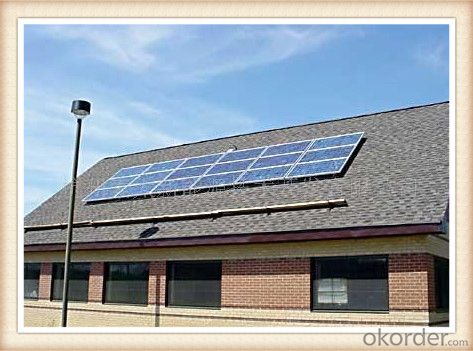
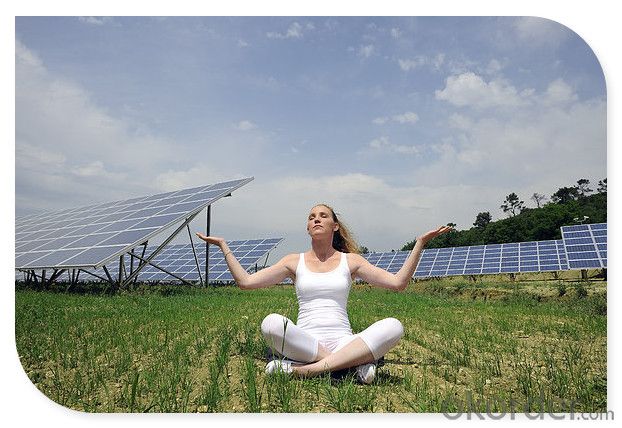
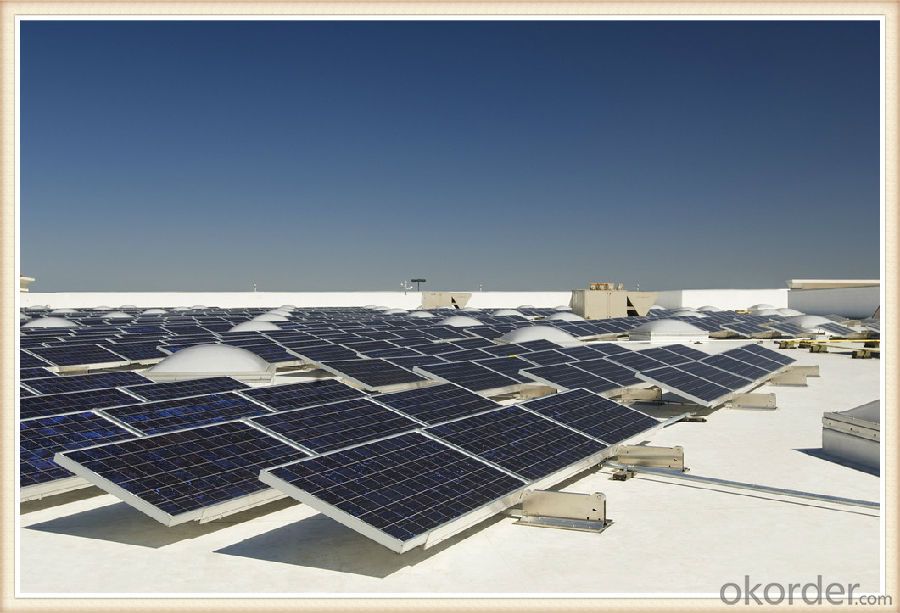
Solar Module Introduction
Solar modules use light energy (photons) from the sun to generate electricity through the photovoltaic effect. The majority of modules use wafer-based crystalline silicon cells or thin-film cells based on cadmium telluride or silicon. The structural (load carrying) member of a module can either be the top layer or the back layer. Cells must also be protected from mechanical damage and moisture. Most solar modules are rigid, but semi-flexible ones are available, based on thin-film cells. These early solar modules were first used in space in 1958.
Electrical connections are made in series to achieve a desired output voltage and/or in parallel to provide a desired current capability. The conducting wires that take the current off the modules may contain silver, copper or other non-magnetic conductive transition metals. The cells must be connected electrically to one another and to the rest of the system. Externally, popular terrestrial usage photovoltaic modules use MC3 (older) or MC4 connectors to facilitate easy weatherproof connections to the rest of the system.
Specification
Model Type | |
Peak Power-Pmax(W) | 5-200W |
Open Circuit Voltage-Voc(V) | 44.2 |
Maximum Power Voltage-Vmp(V) | 36 |
Short Circuit Current-Isc(A) | 5.4 |
Maximum Power Current-Imp(A) | 5 |
Maximum System Voltage | 1000V DC |
Maximum Series Fuse Rating | 10A |
Power Tolerance | -1~+3% |
Temperature Coefficients of Pmax | -0.45%/℃ |
Temperature Coefficients of Voc | -0.348%/℃ |
Temperature Coefficients of Isc | 0.031%/℃ |
Nominal Operating Cell Temperature | 44.5±2℃ |
Standard Testing Condition(STC) | Irradiance:1000W/m²;Temperature:25℃;AM=1.5 |
Qualification Test Parameters | |
Operating Temperature | -40℃~+85℃ |
Storage Temperature | -40℃~+85℃ |
Pressure Bearing | ≥5400Pascal/m² |
Wind Bearing | ≥5400Pascal/m² |
Mechanical Characteristics | |
Cell Size | Mono 125*125mm±0.5 |
No.of Cells | 72pcs(6*12) |
Dimension | 1580*808*40mm |
Weight | 15.5Kg |
Glass | 3.2mm High Transmission,Low Iron |
Frame | Anodized Aluminum Alloy |
Junction Box | IP65Rated |
Internal Diodes | 3 Bypass Diodes |
Cable | 1*4.0mm² Length 900mm |
Images
Packing & Shipping:
We have rich experience on how to pack the panels to make sure the safety on shipment when it arrives at the destination.
The normal size is packed by 25pcs/ carton / pallet. Paper carton for FCL shipping and wood carton for LCL shipping.
Features
1.High reliability with guaranteed -3% to +5% power output tolerance, ensuring return on investment
2.High conversion efficiency based on leading innovative photovoltaic technologies
3.Withstands high wind-pressure and snow load, and extreme temperature variations
4.Attractive appearanceUnique frame design, high mechanical strength, and easy Installation
Warranty:
For c-Si panel: 25years output warranty for no less than 80% of performance, 10 years output warranty for no less than 90% of performance. Free from material and workmanship defects within 5 years.
For a-Si panel: 20 years output warranty for no less than 80% of performance, 10 years output warranty for no less than 90% of performance. Free from material and workmanship defects within 2 years.
•100% product quality protection
•100% on-time shipment protection
•100% payment protection for your covered amount
FAQ:
(1)What price for each watt?
It depends on the quantity, delivery date and payment terms.
(2)What is your size for each module? Can you tell me the Parameter of your module?
We have different series of panels in different output, both c-Si and a-Si. Please take the specification sheet for your reference.
(3)Can you provide the peripheral products of the solar panels, such as the battery, controller, and inverter? If so, can you tell me how do they match each other?
Actually we are only manufacturer of solar panels, but we could try to source them for you in China if you need. We could provide you an optimal system design to instruct you how to install.
(4)Do you have the CE, TUV, UL Certification?
We’ve already passed all the tests, and any certificate is available.
(5)Have you ever sold your products to companies in my country?
Of course, we have customers in all general PV markets, but I think we should expand our market share along with the market growth.
(6)When did your company set up? You are a new company, how can I believe your quality?
We entered into Solar PV industry in 2005, now we have several plants in manufacturing of a-Si and c-Si panels, and our capacity is 220MW per year. Till now we have already passed all the tests by authorized laboratories, e.g. TUV, VDE, UL.
(7)Can you help us install the module if we cooperate with you?
We haven’t entered into installation sector, but we have the plan in near future.
(8) How do you pack your products?
We have rich experience on how to pack the panels to make sure the safety on shipment when it arrives at the destination.
(9) Can you do OEM for us?
Yes, we can.
(10)Can we visit your factory?
Surely, I will arrange the trip basing on your business schedule.
- Q: What is the efficiency of modern solar panels?
- The efficiency of modern solar panels varies, but on average, it ranges from 15% to 20%. Some high-end panels can achieve efficiencies of up to 25%. However, it's important to note that the efficiency of solar panels is constantly improving as technology advances.
- Q: A solar panel facing the sun at noon in mid-summer receives more intensity of the light than when it is at horizontal. However, it can receives more total solar energy when it is at horizontal than when it is tilted during a long summer day. Regradless if it is shaded by building or trees. why is that so?
- Angle is everything. The more angled away from perpendicular, the more light energy simply bounces away. Think of it like a windmill that can only spin, it can't change direction with the wind. If the wind is pointed through the vanes, the vanes turn and power is generated. If the wind is coming from the side, nothing moves and no power is generated.
- Q: I have to get a lot of information on how solar panels are developed and distributed in America because I have to do two pages on this. Please help me get information in this I really need it!! Thankss...
- The first link below is one of the best sites for recent news about solar panels. You should be able to find stories about solar panels under development today. A little bit of the history: Solar panels have been around for about 50 years now. They were first used to power spacecraft. Solar power for domestic use started to develop rapidly in the 970's during the first oil crisis, but as energy prices fell in the 980's solar development slowed. Most of the large solar panel makers were purchased by large oil companies who seemed not to be too interested in solar. In the late 990's as concerns about both Peak Oil and Global Warming grew there was renewed interest in solar power and a number of new companies were started to develop new kinds of solar panels. Many of these new companies have grown larger than the older solar companies still owned by big oil companies. Over the last 7 years or so growth in the solar market has been explosive with a compound growth rate of almost 40% per year. In 2005 the solar industry for the first time started to consume more silicon than all other electronic industries combined resulting in a world wide silicon shortage that is still with use. New silicon refineries are coming on line and the shortage is expected to diminish by 2008 or 2009. Check out the two links below. They will help you a lot.
- Q: What controllers and all that stuff do I need for these solar panels. Oh and the the batteries will be rigged up to a big electric motor so please leave information on how to wire the batteries to the motor...THANKS!!! 0 POINTS!
- Many solar panels wired in parallel, 2 volt solar regulator, 2 volt battery e.g. 30 Ah, 240 volt inverter, autotransformer that can go down to 50 volts. There are many parameter to the electric motor missing. AC or DC, current needs for full load. How many watts the motor uses and the number of hours required will influence the solar panel, regulator and inverter specifications.
- Q: Can solar panels be installed on south-facing windows?
- Yes, solar panels can be installed on south-facing windows as long as the windows receive sufficient sunlight throughout the day.
- Q: Can solar panels be installed on swimming pool covers?
- Yes, solar panels can be installed on swimming pool covers. This allows the pool cover to generate solar energy, which can be used to heat the pool water and reduce energy costs.
- Q: Can solar panels be used in areas with high levels of snowfall?
- Yes, solar panels can still be used in areas with high levels of snowfall. While snow accumulation on the panels can temporarily reduce their efficiency, modern solar panel designs and technologies have improved to withstand heavy snow loads. Additionally, the angle at which solar panels are installed and their smooth surface can help snow easily slide off, allowing them to continue generating electricity even in snowy conditions.
- Q: Can solar panels be used for powering a wastewater treatment plant?
- Yes, solar panels can be used to power a wastewater treatment plant. Solar energy can be harnessed and converted into electricity, making it a sustainable and environmentally friendly option for powering such facilities. The generated electricity can be utilized to operate various equipment and processes involved in wastewater treatment, reducing dependency on traditional power sources and minimizing the carbon footprint of the plant.
- Q: My family moved into a house that came with solar power panels but they are not connected and don't really understand how to even begin.
- You need to know some electrical basics. You need to check if they are still working and determine the output voltage with the use of testers. They are just part of a system that includes other equipments as well like a controller, car batteries, inverters, diodes.
- Q: Mitsubishi Solar Panels For Home Installation: How Much Do The Panels Cost?
- Panels will cost in the range of 300-600 dollars for about 00 watts on average ( enough for one large lightbulb to run a few hours a day). The rest of the system needed will cost $2500-$4000. That is for the equipment. Cost for Installation?? Figure about 0 year life on equipment. It will probably never pay back investment, but will cut power usage. You can reduce power usage much more cost effectively buy simply conserving (Hot water temp. down, CFE bulbs, Better insulation, Better windows, Heat/Air a little colder/hotter, Attic ventilation, Geo Thermal heating/colling system). All of these measures will pay back sooner and save power usage. Solar will never pay back without major subsidies from the taxpayers. Particularly if in an area that has many cloudy days. Check it out. The calculations are basic and the facts are available if you really want them. Don't believe any salesmen or Environmentalists. They don't want you to know the facts.
Send your message to us
Dometic Solar Panels 20w Direct Factory Sale Price 260-300watt
- Loading Port:
- China main port
- Payment Terms:
- TT OR LC
- Min Order Qty:
- 10000 watt
- Supply Capability:
- 100000 watt/month
OKorder Service Pledge
OKorder Financial Service
Similar products
Hot products
Hot Searches
Related keywords
